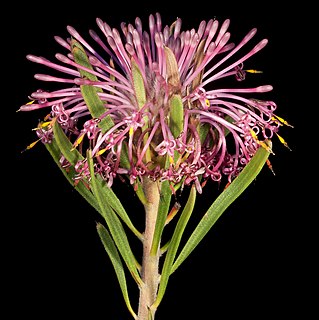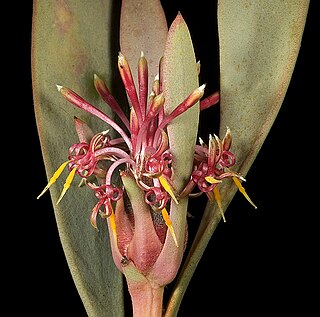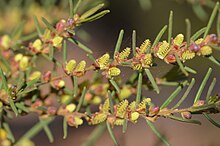Banksia densa is a species of column-like shrub that is endemic to Western Australia. It has deeply serrated to pinnatifid leaves, creamy yellow flowers in heads of up to seventy-five, and hairy follicles.

Banksia purdieana is a species of bushy shrub that is endemic to Western Australia. It has broadly linear, pinnatipartite leaves with sharply-pointed lobes on the sides, yellow flowers in heads of about eighty and egg-shaped follicles.

Pimelea glauca, commonly known as smooth riceflower, is a species of small shrub in the family Thymelaeaceae and is endemic to Australia. It is not considered to be threatened.
Muniria angustisepala is a flowering plant in the mint family Lamiaceae and is endemic to the Northern Territory. It is an erect shrub with softly hairy, warty leaves and pale yellow, woolly flowers.

Lawrencia squamata is a species of plant in the mallow family, Malvaceae. It is endemic to Australia and occurs in all Australian states.

Chenopodium spinescens is a species of plant in the family Amaranthaceae and is endemic to all mainland states and territories of Australia where it is known as Rhagodia spinescens.

Homoranthus cernuus is a flowering plant in the family Myrtaceae and is endemic to a small area in the Wollemi National Park. It is a slender shrub with smooth, linear shaped leaves and pairs of pendulous cream-coloured flowers with a pinkish base.

Bossiaea rupicola is a species of flowering plant in the family Fabaceae and is endemic to eastern Australia. It is an erect shrub or small tree with silky-hairy, narrow egg-shaped to narrow elliptic leaves and red flowers with yellow markings.

Calandrinia corrigioloides is an annual herb in the family Montiaceae, and is native to Western Australia, South Australia, and Victoria.

Calandrinia granulifera is an annual herb in the family Montiaceae, and is native to New South Wales, Tasmania, Western Australia, South Australia, and Victoria.

Isopogon longifolius is a small shrub in the family Proteaceae that is endemic to the southwest of Western Australia.

Isopogon linearis is a small shrub in the family Proteaceae that is endemic to the southwest of Western Australia.

Isopogon pruinosus is a species of flowering plant in the family Proteaceae and is endemic to southwestern Western Australia. It is a compact, spreading shrub with narrow egg-shaped leaves with the narrower end towards the base and spherical to elliptic heads of pink flowers.

Cecarria is a monotypic genus in the family Loranthaceae. The sole species is Cecarria obtusifolia, a hemiparasitic aerial shrub.

Scaevola argentea, is a low growing, branching shrub in the family Goodeniaceae.

Scaevola browniana is a shrub in the family Goodeniaceae, endemic to Western Australia, the Northern Territory and Queensland.

Scaevola amblyanthera is a small shrub in the family Goodeniaceae which is found in tropical and central Australia.

Bertya opponens is a shrub/tree in the family Euphorbiaceae, native to Australia and found in New South Wales and Queensland. It is found on ridges amongst mallee in shallow soils. It flowers in July and August.

Sida spenceriana is a small plant in the family Malvaceae found in Queensland, the Northern Territory and Western Australia

Tacca maculata is a plant in the Dioscoreaceae family, native to Western Australia, the Northern Territory, Fiji and Samoa





















